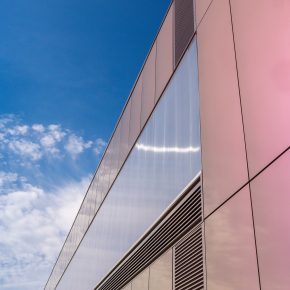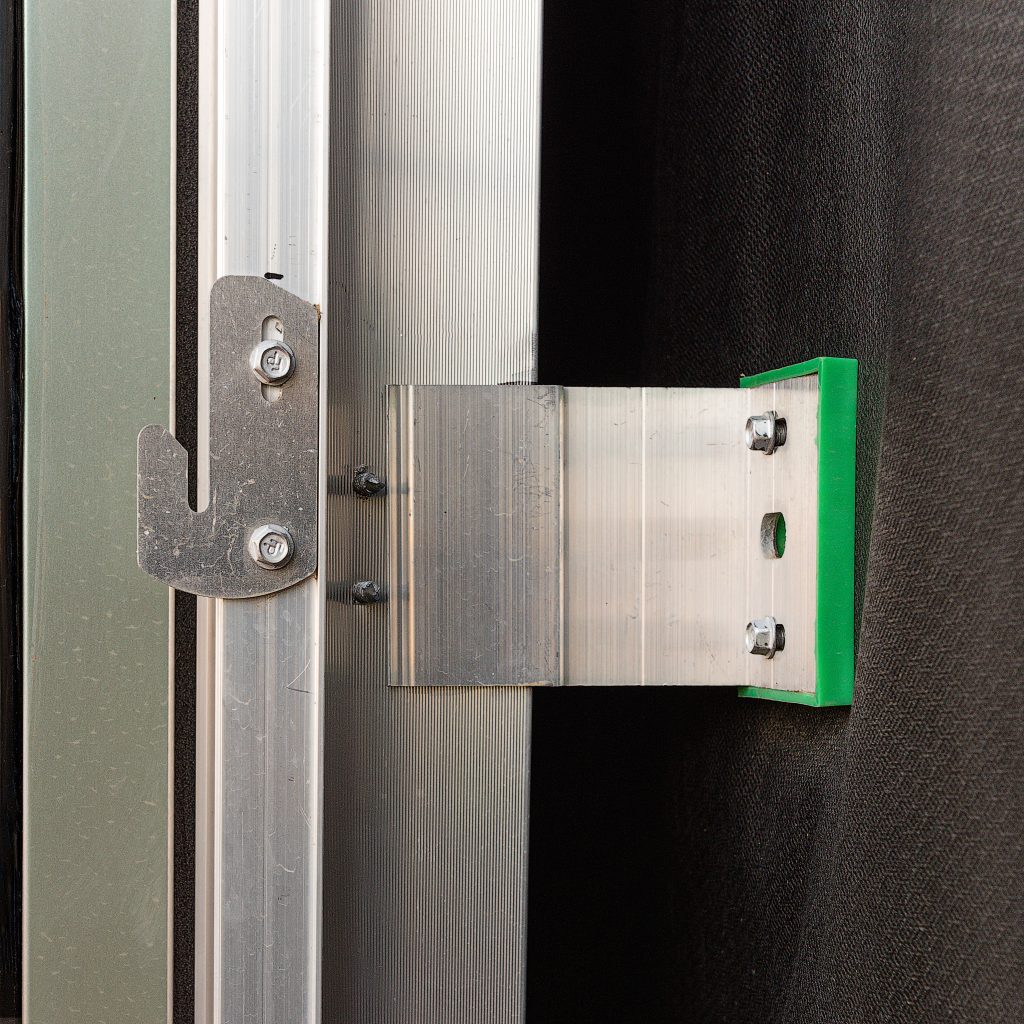
SFS: Creating new futures for older buildings – the rising role of upcycling
Rising demand for construction has gone hand in hand with an increased focus on sustainability. By repurposing older buildings for today’s needs, upcycling brings these two factors neatly together. Here, Simon Fielden, Sales Director at SFS, looks at the role of the building envelope in upcycling, using an example from Britain’s home of motor racing.
“Sustainability in construction is now a given, and the whole industry is working hard to minimise time, costs and environmental impact. We build with sustainable products. We use just-in-time logistics. We’ve embraced modular construction and digitalisation, and we recycle materials at the end of life.
To this we can now add upcycling – or breathing new life into older buildings. This is more than simply a refit or refurbishment. It’s about changing the building’s identity and giving it new value. We’ve all seen TV programmes where people have transformed old furniture into things of real beauty. Building upcycling works to the same principle, just on a far grander scale.
This is a good trend, and not just from the point of view of sustainability. The fact is, while our city landscapes feature many stunning modern architectural designs, they also feature less attractive buildings. While some argue that these should be demolished and replaced it’s not always quite so simple.
Quite apart from the mess and disruption, these buildings are often people’s homes and communities. A better, more sustainable approach is to upcycle them. While work can be done internally, the big dramatic transformations take place externally. And the building envelope has a very central role to play in this work.
The Silverstone experience – a total re-imagining
A recent project at Silverstone provides a good example. Looking to create a new visitor centre focussed on the history and achievements of British motor racing, Silverstone Heritage Ltd decided to house it in a building with history – a World War II aircraft hangar. This wasn’t a restoration, it was a total re-imagining.
Created by Cube Design and part funded by the Heritage Lottery, the £19.3 million project features an iridescent exterior made from PPC aluminium rainscreen panels with Spectra finish. Installed by UEFS Ltd, the panels were fixed to the main structure using SFS’ NVELOPE NV7 system which was developed for concealed fix cassette applications.

Comprising T and L profiles fixed with support brackets through a series of fixed and flexible points, this allowed for expansion and contraction, while the fixed-point brackets absorbed vertical dead loads.
This project provides useful insight into the issues surrounding the building envelope, and the sort of things which need to be considered.
Creating the right effect
Design comes first. Today there’s a huge amount of envelope choice, both in colours and materials – ranging from metals and natural stone through to high pressure laminates and fibre cement. So, whether you’re creating a colourful primary school or a more prestigious development, it’s possible to create the right effect.
It’s the role of the architect to do the imagining, but it’s the role of the manufacturers of building envelope materials and fixings to help them realise their vision. Equally, it’s their responsibility to make sure that contractors and installers get the right advice, support and products to ensure successful project delivery. Forging partnerships from the start can save time and effort further down the line.
A smarter way to work
Calculation is a key area, and to secure the materials and provide a stable, long-term solution, it’s important to get the right fixtures and fittings for the application. For example, with masonry concrete it’s vital to ensure that the correct number of pull-out and pull-over tests have been completed. Such calculations are no longer the time-consuming trial they once were, and digital has come to the rescue, helping the industry work smarter.
SFS’ own Project Builder for example has been developed to provide quick and reliable static calculations for its systems in both general and corner building areas. You simply key in known factors including local wind loads, façade height, materials and substrate, and with a simple push of the button you generate the right NVELOPE cladding and support solution for your project.

This peace of mind means that you’re not just securing the envelope properly and safely, but you’re also securing the future of the building and people within it – and that’s a critical consideration in sustainable building.
Another key aspect is logistics and ensuring a reliable and timely supply of products. Typically, high rise projects are delivered in phases, usually by elevation, in order to minimise local disruption.
Again, you can optimise this process by engaging with manufacturers and openly sharing your schedules. They can then dovetail production with your plans to help keep everything on track, minimising delays and rising capital costs. It might also be worthwhile considering British manufacturers – a more reliable way to counter the double challenges of COVID-19 and Brexit.
Transforming buildings – and experiences
Peace of mind also comes from approvals, without which many projects won’t even get off the ground. To provide assurance, all of SFS’ products are BBA certified which means they have been thoroughly tested and audited for everything including energy efficiency and durability. BBA certification is also accepted by local government, building authorities and insurance companies, so offers additional reassurance.
The question of warranties is equally important, and one that’s often overlooked in terms of the building envelope. Contractors frequently use brackets, rail and fixings from a variety of manufacturers. Clearly, while each is covered by a warranty, the duration and details will vary.
Specification and application issues therefore could potentially lead to complications at a later stage. Using a single manufacturer, with fully integrated and compatible components helps eliminate this risk. All of SFS’ products for example, are covered both by a common guarantee and by our technical support teams.
Upcycling, then, has huge potential to transform buildings, landscapes and end-user experiences – but it’s not without its own unique challenges and considerations. One thing is for sure – it’s not a trend, but a practice that’s here to stay.
It’s sustainable, practical and cost-effective and, by taking the right approach, with the right supplier, upcycling projects can deliver imaginative and inspiring buildings that will last for generations to come.”
For more about SFS, please visit www.sfsintec.co.uk
Contact
SFS Group Fastening Technology Ltd
153 Kirkstall Road
Leeds
LS4 2AT
Phone number : +44 (0)330 0555 888
Email : [email protected]
Visit Supplier's page
Latest news

22nd November 2024
Pop Up Power Supplies Gets Arty in Yorkshire
Pop Up Power Supplies has installed 13 new electricity units at The Hepworth Wakefield – read more in this article…
Posted in Articles, Building Industry News, Building Products & Structures, Building Services, Case Studies, Civil Engineering, Facility Management & Building Services, Garden, Hard Landscaping & Walkways, Landscaping, Posts, Restoration & Refurbishment, Retrofit & Renovation
22nd November 2024
OPT Services Revolutionises Fibre Cable Capping with Eco-Friendly Innovation
UK-based OPT Services has unveiled SlimLine™ Capping, a groundbreaking fibre cable protection solution that promises to deliver significant environmental and installation advantages to the fibre optic industry.
Posted in Articles, Building Industry News, Building Products & Structures, Building Services, Facility Management & Building Services, Information Technology, Innovations & New Products, Sustainability & Energy Efficiency
22nd November 2024
CRL: The elegance of Paris balconies - a modern touch for any home
Paris balconies, with their timeless charm and practicality, are becoming something of an architectural staple in urban and rural environments, as CRL explains here…
Posted in Articles, Balustrades and Guardrails, Building Industry News, Building Products & Structures, Case Studies, Garden, Glass, Glass Projects, Restoration & Refurbishment, Retrofit & Renovation
21st November 2024
Altro distils style and performance at English Spirit
English Spirit Distillery has used an extensive package of Altro products front and back of house, in their new visitor centre café, shop and viewing area for the working distillery.
Posted in Articles, Bathrooms, Bedrooms & Washrooms, Building Industry News, Building Products & Structures, Building Systems, Case Studies, Floors, Interior Design & Construction, Interiors, Kitchens, Restoration & Refurbishment, Retrofit & Renovation, Timber Buildings and Timber Products, Walls
 Sign up:
Sign up: